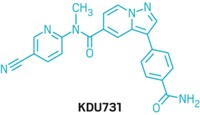Advertisement
Grab your lab coat. Let's get started
Welcome!
Welcome!
Create an account below to get 6 C&EN articles per month, receive newsletters and more - all free.
It seems this is your first time logging in online. Please enter the following information to continue.
As an ACS member you automatically get access to this site. All we need is few more details to create your reading experience.
Not you? Sign in with a different account.
Not you? Sign in with a different account.
ERROR 1
ERROR 1
ERROR 2
ERROR 2
ERROR 2
ERROR 2
ERROR 2
Password and Confirm password must match.
If you have an ACS member number, please enter it here so we can link this account to your membership. (optional)
ERROR 2
ACS values your privacy. By submitting your information, you are gaining access to C&EN and subscribing to our weekly newsletter. We use the information you provide to make your reading experience better, and we will never sell your data to third party members.
Environment
Funding for Rare Disorders
June 18, 2007
| A version of this story appeared in
Volume 85, Issue 25
The story on autism, a complex spectrum of disorders, is timely and appropriate (C&EN, May 14, page 32). Autism manifests at birth or is recognized in childhood. Although autism is not life-threatening, the economic and social burden it imposes is enormous and deserves much research to fully understand the disease.
Given the complexity of autism and its many subclasses, each subclass population becomes even smaller. Diseases whose prevalence is one in 25,000 or one in 8,000 people are no less important and deserve no less attention than common diseases. There are more than 6,600 rare diseases in the U.S.; for some, only a handful of people are affected, but the combined population of people with rare diseases is more than 15% of the population in the U.S. alone.
Total funding received from the National Institutes of Health for orphan diseases, particularly for understanding the cause of disease, is extremely small compared with the funding for mainstream diseases. Because there are no economic incentives, not many drug companies are interested in understanding the etiology of rare diseases. Government and the public should support such research, at least to its proportionality with common diseases.
Ramaiah Muthyala
Minneapolis



Join the conversation
Contact the reporter
Submit a Letter to the Editor for publication
Engage with us on Twitter